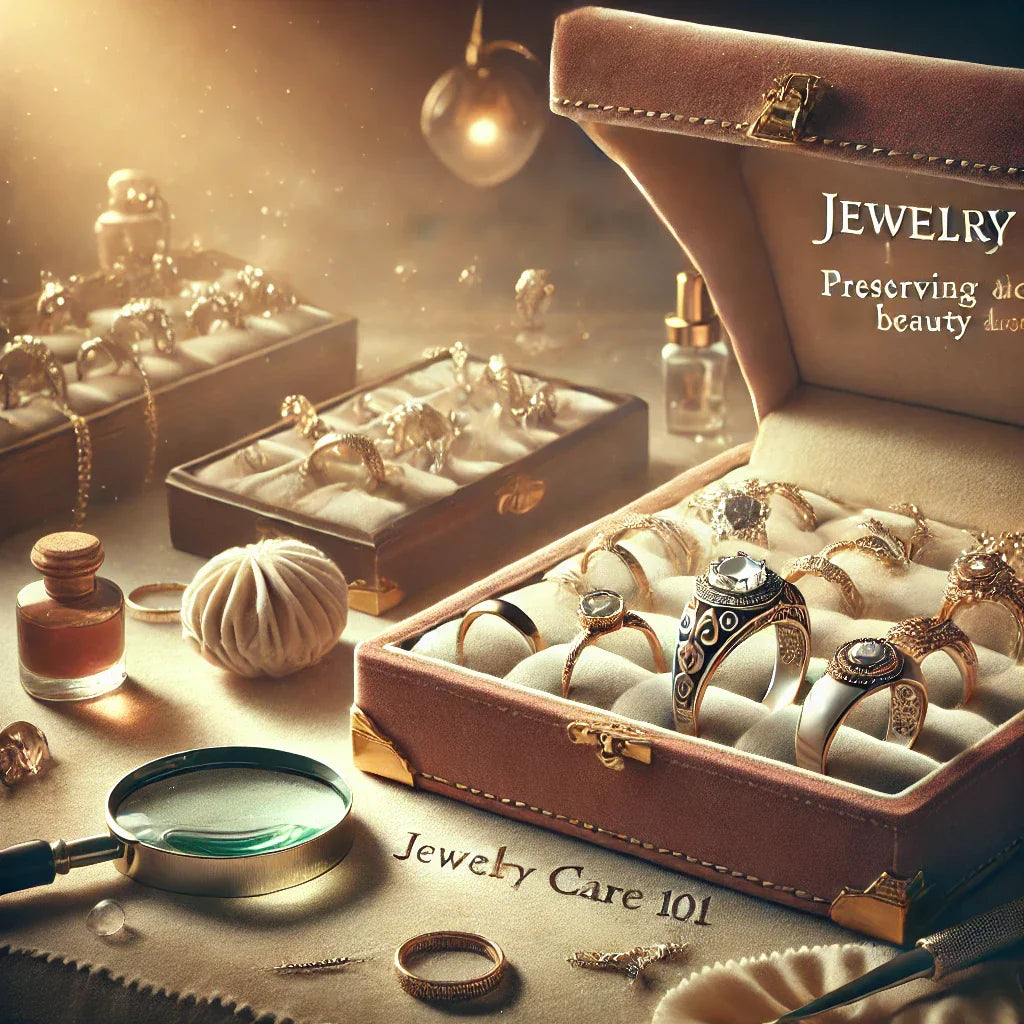
Jewelry Care 101: Preserving Beauty and Craftsmanship
Share
Cherishing Your Treasures
Jewelry elevates your style and holds deep sentimental and monetary value. A dedicated care routine helps ensure that your favourite pieces remain brilliant and intact for years. In this guide, you'll find everyday cleaning techniques, practical home remedies, tailored care tips for pearls, sterling silver, gold, and gemstones, and insights into handcrafted jewelry's unique value.
General Cleaning Techniques
Maintaining your jewelry's shine starts with regular cleaning to remove accumulated dirt, oils, and chemicals. A simple yet effective method involves soaking your pieces in warm water with a few drops of mild dish soap, then gently scrubbing crevices with a soft brush like a toothbrush. This gentle approach works well for most jewelry, keeping them fresh without causing any damage.
Home Remedies for Everyday Cleaning
Many common household ingredients can serve as eco-friendly cleaning solutions. For instance, water and white vinegar are excellent for removing tarnish from sterling silver. In contrast, baking soda and water paste can polish away grime on sturdier pieces. Additionally, a damp microfiber cloth with a touch of lemon juice can help restore the lustre of metal surfaces—just be sure to rinse thoroughly afterward.

Caring for Specific Jewelry Types
Different materials require different care. Delicate pearls should never be soaked; gently wipe them with a soft, damp cloth after each wear and keep them away from chemicals like hairspray or perfume. Gemstones usually benefit from mild, soapy water and a soft brush, but steer clear of harsh chemicals or ultrasonic cleaners, especially for porous stones like opals or emeralds. Sterling silver can be revived with a water and vinegar solution or a specialized polishing cloth. At the same time, gold jewelry is best maintained with a mild soap solution and careful brushing, followed by thorough rinsing and drying.

Inspection and Professional Maintenance
Regularly inspect your jewelry for any signs of damage, such as loose stones, worn prongs, or broken clasps. Early detection of these issues can prevent further damage or loss. If you notice any irregularities, consult a professional jeweller for evaluation and repair. Timely maintenance not only preserves the beauty of your jewelry but also safeguards your valuable investments.

The Unique Value of Handcrafted Jewelry
Beyond daily care, consider the lasting appeal of handcrafted jewelry. Unlike mass-produced items, handmade pieces are created with passion and precision by skilled artisans, ensuring each item carries a unique story and personal touch. This artisanal approach adds character and individuality to every piece, making it more than an accessory.
Cherishing Your Treasures
Jewelry elevates your style and holds deep sentimental and monetary value. A dedicated care routine helps ensure that your favourite pieces remain brilliant and intact for years. In this guide, you'll find everyday cleaning techniques, practical home remedies, and tailored care tips for pearls, sterling silver, gold, gemstones, and even copper jewelry, along with insights on the unique value of handcrafted jewelry.

General Cleaning Techniques
Maintaining your jewelry's shine starts with regular cleaning to remove accumulated dirt, oils, and chemicals. A simple yet effective method involves soaking your pieces in warm water with a few drops of mild dish soap, then gently scrubbing crevices with a soft brush like a toothbrush. This gentle approach works well for most jewelry, keeping them fresh without causing any damage.
Home Remedies for Everyday Cleaning
Many common household ingredients can serve as eco-friendly cleaning solutions. For instance, water and white vinegar are excellent for removing tarnish from sterling silver. In contrast, baking soda and water paste can polish away grime on sturdier pieces. Additionally, a damp microfiber cloth with a touch of lemon juice can help restore the lustre of metal surfaces—just be sure to rinse thoroughly afterward.

Caring for Specific Jewelry Types
Different materials require different care routines:
- Pearls: Delicate and lustrous; pearls should never be soaked. Instead, gently wipe them with a soft, damp cloth after each wear and keep them away from chemicals like hairspray or perfume.
- Gemstones: Most gemstones benefit from mild, soapy water and a soft brush, but avoid harsh chemicals or ultrasonic cleaners, especially for porous stones like opals or emeralds.
- Sterling Silver: This metal can be revived with a water and vinegar solution or a specialized silver polishing cloth to remove tarnish.
- Gold Jewelry: Maintain gold pieces with a mild soap solution and a soft toothbrush, followed by thorough rinsing and drying to preserve their natural glow.
- Copper Jewelry: Copper tends to tarnish over time, but you can restore its shine using a homemade cleaning solution. Mix lemon juice with a pinch of salt to form a paste, gently rub it onto the copper surface, let it sit for a few minutes, and then rinse with warm water. You can also use a soft cloth dipped in vinegar for a deeper clean. Always dry your copper jewelry thoroughly to prevent further oxidation.

Inspection and Professional Maintenance
Regularly inspect your jewelry for any signs of damage, such as loose stones, worn prongs, or broken clasps. Early detection of these issues can prevent further damage or loss. If you notice any irregularities, consult a professional jeweller for evaluation and repair. Timely maintenance not only preserves the beauty of your jewelry but also safeguards your valuable investments.
The Unique Value of Handcrafted Jewelry
Beyond daily care, consider the lasting appeal of handcrafted jewelry. Unlike mass-produced items, handmade pieces are created with passion and precision by skilled artisans, ensuring each item carries a unique story and personal touch. This artisanal approach adds character and individuality to every piece, making it more than an accessory.
Craftsmanship and Personalization
Handcrafted jewelry is meticulously assembled by artisans who pay close attention to every detail, resulting in highly customizable and unique designs. This personalized craftsmanship starkly contrasts mass production's uniformity, offering a more intimate connection between the wearer and the creator and often leading to pieces that reflect personal style.

Quality and Durability
Artisans typically use high-quality materials and time-honoured techniques passed down through generations to create handcrafted jewelry. This commitment to excellence ensures that each piece is beautiful and durable enough to withstand daily wear. In contrast, mass-produced items may prioritize cost efficiency over longevity, sometimes compromising material quality and artistry.
Heirloom Potential
One of the most appealing aspects of handcrafted jewelry is its potential to become a cherished heirloom. These pieces often carry significant sentimental value and can be passed down through generations, with each new owner adding their own story. The lasting beauty and enduring quality of handcrafted jewelry transform it from a simple accessory into a family legacy.
Conclusion: An Investment in Art and Legacy
Combining a careful jewelry care routine with the timeless appeal of handcrafted pieces creates a dual investment: one in the immediate beauty of your collection and another in the legacy it can become. While mass-produced jewelry offers uniformity and lower prices, handcrafted items provide unmatched uniqueness, superior quality, and the potential to become treasured family heirlooms. Embrace thoughtful care and artisanal craftsmanship to ensure your jewelry continues to shine and tell its story for generations.



